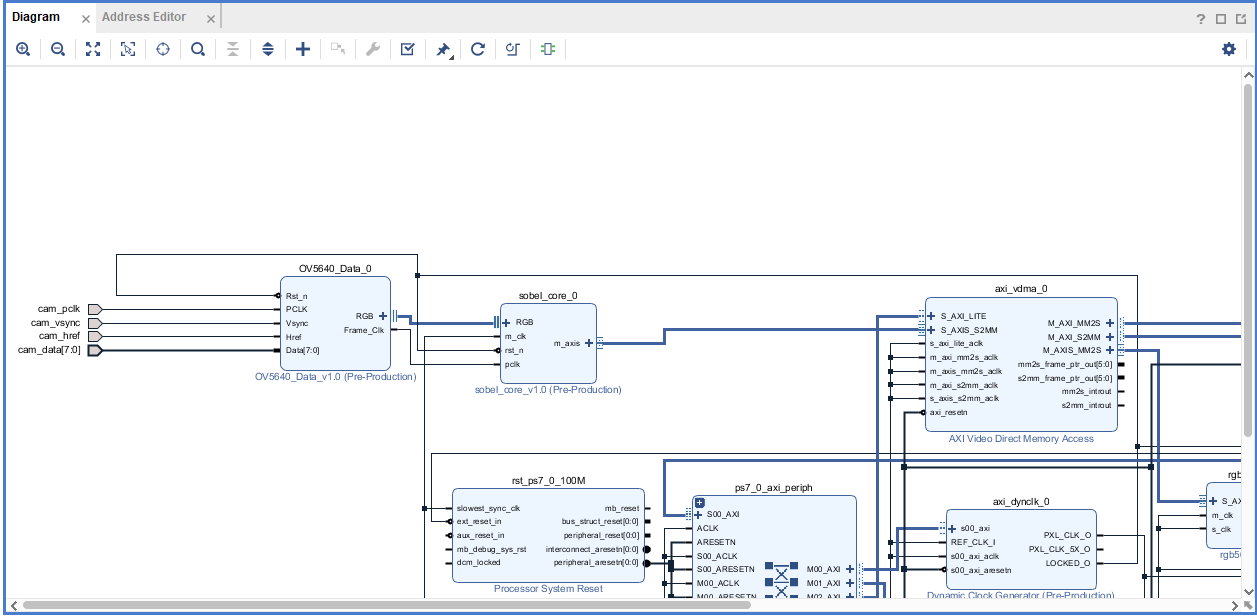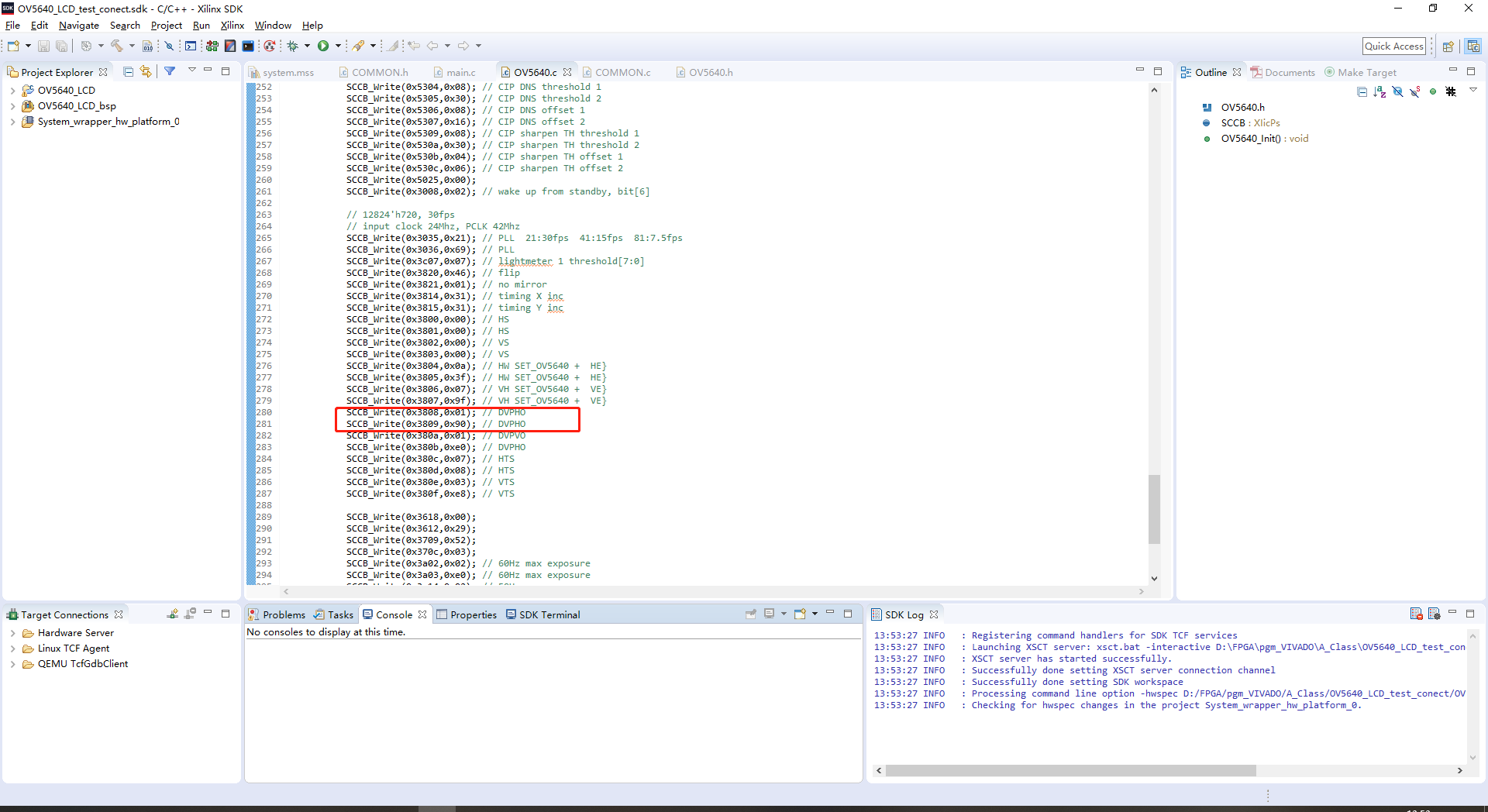基于ZYNQ的OV5640摄像头的sobel算子边缘检测
1、sobel算子
Sobel 算法是像素图像边缘检测中最重要的算子之一,在机器学习、数字媒体、计算机
视觉等信息科技领域起着举足轻重的作用。在技术上,它是一个离散的一阶差分算子,用来
计算图像亮度函数的一阶梯度之近似值。在图像的任何一点使用此算子,将会产生该点对应
的梯度矢量或是其法矢。
Sobel 边缘检测通常带有方向性,可以只检测竖直边缘或垂直边缘或都检测。
实现步骤:
第一步:Sobel 提供了水平方向和垂直方向两个方向的滤波模板。设 x 方向和 y 方向
的卷积因子分别为 Gx和 Gy,模板如下所示,A 为原图像。

第二步:矩阵运算后,就得到横向灰度值 Gx 和纵向灰度值 Gy,然后通过如下公式进
行计算出该点的灰度值:

这个运算比较复杂,涉及到平方和开根(FPGA 不擅长),可以采用取近似值计算方法,对
于最终结果影响不大

第三步:设置一个阈值 threshold,对数据进行比较然后输出二值图像
2、图像灰度算法
图像数据中,含有RGB三种颜色的数据,如果一起处理的话,要很大的的运算量和位宽,为了减小运算量,可以将24位的RGB数据转化为8位的灰度图像。
虽然丢失了一些颜色等级,但是从整幅图像的整体和局部的色彩以及亮度等级分布特征来看,灰度图描述与彩色图的描述是一致的。一般有分量法、最大值法、平均值法、加权平均法四种方法对彩色图像进行灰度化。
然后本次采用的是平均值法。
将彩色图像中的三分量亮度求平均得到一个灰度值。如下:

上式中有除法,考虑到在 FPGA 中实现除法比较的消耗资源,这里在实现前可以先做
如下的近似处理。可以将上面公式乘以 3/256,这样就需要同时乘以 256/3 保证公式的正确
性。公式处理过程如下:

对 256/3 做近似取整处理,将 256/3 替换成 85,则公式变为如下。

这样式子中除以 256 就可以采用移位方法来处理,式子变为如下:

上面处理过程中使用是对 256/3 的近似处理,当然这里可以采用其他数据,比如
512/3、1024/3、2048/3 等等,基本的原则是将平均公式法中分母的 3 替换成 2 的幂次的
数,这样除法就可以使用移位的方式实现,减小 FPGA 中由于存在除法带来的资源消耗。
3、sobel算法的实现
该工程用到的算子需要三行数据才能进行,我们可以先缓存两行数据,然后接下来的输入数据加上之前缓存的两行的数据就是三行数据了,示意图如下:

缓存区像移位寄存器一样,一个周期输入一个数据和输出一个数据,可以用xilinx的RAM-base Shift Register IP核来实现。
但上面仅实现31的模板,要实现33的模板可在每行输出串联三组寄存器,以下是示意图:

然后我们就可以取寄存器组里面的值进行Sobel 算法的实现了。
4、sobel算法模块
本模块需要
- 1个16位宽1024深度的异步FIFO
- 2个16位宽1024深度的同布FIFO
- 2个8位宽400深度RAM-base Shift Register IP核
sobel_core_v1_0.v
`timescale 1ns / 1ps ////////////////////////////////////////////////////////////////////////////////// // Company: GDUT // Engineer: Lclone // // Create Date: 2023/03/27 22:04:23 // Design Name: sobel_core // Module Name: sobel_core // Project Name: sobel_core // Target Devices: // Tool Versions: // Description: // // Dependencies: // // Revision: // Revision 0.01 - File Created // Additional Comments: // ////////////////////////////////////////////////////////////////////////////////// module sobel_core_v1_0 # ( parameter LINE_LENGTH = 800, //行长度 parameter LINE_NUM = 480) //场长度 ( //------系统接口--------- input m_clk, //主时钟 input rst_n, //复位信号 //------摄像头接口------- input pclk, //像素时钟 input [15:0] cam_data, //图像数据输入 input data_valid, //数据有效 //------maxis接口-------- input m_axis_tready, output reg m_axis_tvalid, output [15:0] m_axis_tdata, output reg m_axis_tlast, output m_axis_tuser ); //------------------cam_fifo的信号----------------------------- reg cam_fifo_data_rd_en; //cam_fifo 读使能 reg cam_fifo_data_rd_en_r; wire [15:0] cam_fifo_data_out; //cam_fifo读出数据 wire [ 9:0] rd_data_count; //cam_fifo读出计数 //------------------图像灰度算法的信号------------------------ wire [ 9:0] sum; reg [15:0] gray_r; wire [ 7:0] gray_8b_o; reg gray_valid; //-------------------sbole模块信号---------------------------- wire [ 7:0] filter_data_out; wire filter_data_valid; //-------------------两个同步fifo的信号----------------------- wire [15:0] fifo_data0; wire [15:0] fifo_data1; wire [ 9:0] fifo_data_count0; wire [ 9:0] fifo_data_count1; reg [ 9:0] out_data_count; reg fifo_flag; //-------------------场计数信号------------------------------- reg [ 8:0] line_cnt; reg line_end; //------------------------------------------------------------ reg m_axis_act; //m_axis活动信号 always@(posedge m_clk or negedge rst_n) begin if(rst_n == 0) cam_fifo_data_rd_en <= 0; else if(rd_data_count >= LINE_LENGTH/2)//当cam_fifo里的数据大于400个的时候,就进行读取 cam_fifo_data_rd_en <= 1; else if(rd_data_count <= 2) //当cam_fifo里的数据小于两个的时候,就暂停读取 cam_fifo_data_rd_en <= 0; else cam_fifo_data_rd_en <= cam_fifo_data_rd_en; end always @(posedge m_clk) cam_fifo_data_rd_en_r <= cam_fifo_data_rd_en; //延一拍,作为写入同步fifo的写信号 always@(posedge m_clk or negedge rst_n) begin if(rst_n == 0) m_axis_act <= 0; else if(fifo_data_count0 >= LINE_LENGTH/2 - 1 ) //当同步fifo0的数据有400个的时候就使axi_stream接口活动 m_axis_act <= 1; else if(fifo_data_count1 <= 1 )//当同步fifo1的数据小于1个的时候就使axi_stream接口暂停活动 m_axis_act <= 0; else m_axis_act <= m_axis_act; end always@(posedge m_clk) m_axis_tvalid <= m_axis_act;//延一拍作为tvalid信号与数据同步 always@(posedge m_clk or negedge rst_n) begin//每行数据的最后一个拉高tlast信号 if(rst_n == 0) m_axis_tlast <= 0; else if(out_data_count == LINE_LENGTH - 2 & m_axis_tvalid) m_axis_tlast <= 1; else m_axis_tlast <= 0; end always@(posedge m_clk or negedge rst_n) begin//场计数器,为给出帧同步信号而设置的。 if(rst_n == 0) line_cnt <= 0; else if(line_cnt == LINE_NUM - 1 & out_data_count == LINE_LENGTH - 1) line_cnt <= 0; else if(out_data_count == LINE_LENGTH - 1) line_cnt <= line_cnt + 1'b1; else line_cnt <= line_cnt; end always@(posedge m_clk or negedge rst_n) begin//输出计数器,为给出tlast,切换fifo,给出帧同步信号而设置的。 if(rst_n == 0) out_data_count <= 0; else if(out_data_count == LINE_LENGTH - 1) out_data_count <= 0; else if(m_axis_tvalid & m_axis_tready) out_data_count <= out_data_count + 1'b1; else out_data_count <= out_data_count; end always@(posedge m_clk or negedge rst_n) begin if(rst_n == 0) line_end <= 0; else if(line_cnt == LINE_NUM - 1 & out_data_count == LINE_LENGTH - 1) line_end <= 1; else line_end <= 0; end assign m_axis_tuser = (out_data_count == 0 & m_axis_tvalid & m_axis_tready & line_cnt == 0)? 1:0; //每个帧的第一个数据拉高tuser,也就是帧同步信号 //-------------------------------------------图像灰度算法------------------------------------------------------ assign sum = {cam_fifo_data_out[15:11],3'b0} + {cam_fifo_data_out[10:5],2'b0} + {cam_fifo_data_out[4:0],3'b0}; always@(posedge m_clk or negedge rst_n) begin if(rst_n == 0) gray_r <= 16'd0; else if(cam_fifo_data_rd_en_r) gray_r <= (sum << 6)+(sum << 4)+(sum << 2)+ sum; else gray_r <= 16'd0; end assign gray_8b_o = gray_r[15:8]; always@(posedge m_clk) begin gray_valid <= cam_fifo_data_rd_en_r; end //------------------------------------------同步fifo的数据切换-------------------------------------------------- always@(posedge m_clk or negedge rst_n) begin if(rst_n == 0) fifo_flag <= 0; else if(out_data_count >= LINE_LENGTH - 1) fifo_flag <= 0; else if(out_data_count >= LINE_LENGTH/2 - 1) fifo_flag <= 1; else fifo_flag <= fifo_flag; end assign m_axis_tdata = (fifo_flag) ? fifo_data1 : fifo_data0; //---------------------------------------------------------------------------------------------------------- fifo_generator_1 cam_data_fifo ( .rst(~rst_n), // input wire rst .wr_clk(pclk), // input wire wr_clk .rd_clk(m_clk), // input wire rd_clk .din(cam_data), // input wire [15 : 0] din .wr_en(data_valid), // input wire wr_en .rd_en(cam_fifo_data_rd_en), // input wire rd_en .dout(cam_fifo_data_out), // output wire [15 : 0] dout .full(), // output wire full .empty(), // output wire empty .rd_data_count(rd_data_count), // output wire [9 : 0] rd_data_count .wr_rst_busy(), // output wire wr_rst_busy .rd_rst_busy() // output wire rd_rst_busy ); fifo_generator_0 fifo_generator_0_inst ( .clk(m_clk), // input wire clk .srst(~rst_n), // input wire srst .din(cam_fifo_data_out), // input wire [15 : 0] din .wr_en(cam_fifo_data_rd_en_r), // input wire wr_en .rd_en(~fifo_flag & m_axis_act & m_axis_tready), // input wire rd_en .dout(fifo_data0), // output wire [15 : 0] dout //m_axis_tdata .full(), // output wire full .empty(), // output wire empty .data_count(fifo_data_count0) // output wire [9 : 0] data_count ); sobel_filter #( .DATA_WIDTH(8)) sobel_filter_inst ( .clk(m_clk), .reset_p(~rst_n), .data_in(gray_8b_o), .data_in_valid(gray_valid), .data_in_hs(1'b1), .data_in_vs(1'b1), .threshold(8'd127), //-------------------------- .data_out(filter_data_out), .data_out_valid(filter_data_valid), .data_out_hs(), .data_out_vs() ); fifo_generator_0 fifo_generator_1_inst ( .clk(m_clk), // input wire clk .srst(~rst_n), // input wire srst .din({{5{filter_data_out[0]}},{6{filter_data_out[0]}},{5{filter_data_out[0]}}}),// input wire [15 : 0] din .wr_en(filter_data_valid), // input wire wr_en .rd_en(fifo_flag & m_axis_act & m_axis_tready), // input wire rd_en .dout(fifo_data1), // output wire [15 : 0] dout .full(), // output wire full .empty(), // output wire empty .data_count(fifo_data_count1) // output wire [9 : 0] data_count ); endmodule
sobel_filter.v
`timescale 1ns / 1ps module sobel_filter #( parameter DATA_WIDTH = 8) ( input clk, input reset_p, input [DATA_WIDTH - 1:0] data_in, input data_in_valid, input data_in_hs, input data_in_vs, input [DATA_WIDTH - 1:0] threshold, //-------------------------- output reg [DATA_WIDTH - 1:0] data_out, output data_out_valid, output data_out_hs, output data_out_vs ); reg [DATA_WIDTH - 1:0] row0_col0; reg [DATA_WIDTH - 1:0] row0_col1; reg [DATA_WIDTH - 1:0] row0_col2; reg [DATA_WIDTH - 1:0] row1_col0; reg [DATA_WIDTH - 1:0] row1_col1; reg [DATA_WIDTH - 1:0] row1_col2; reg [DATA_WIDTH - 1:0] row2_col0; reg [DATA_WIDTH - 1:0] row2_col1; reg [DATA_WIDTH - 1:0] row2_col2; wire [DATA_WIDTH - 1:0] line0_data; wire [DATA_WIDTH - 1:0] line1_data; wire [DATA_WIDTH - 1:0] line2_data; reg data_in_valid_dly1; reg data_in_valid_dly2; reg data_in_valid_dly3; reg data_in_hs_dly1; reg data_in_hs_dly2; reg data_in_hs_dly3; reg data_in_vs_dly1; reg data_in_vs_dly2; reg data_in_vs_dly3; wire Gx_is_positive; wire Gy_is_positive; reg [DATA_WIDTH+1:0] Gx_absolute; //high bit expansion 2bit reg [DATA_WIDTH+1:0] Gy_absolute; //high bit expansion 2bit always @(posedge clk or posedge reset_p) begin if(reset_p) begin row0_col0 <= 'd0; row0_col1 <= 'd0; row0_col2 <= 'd0; row1_col0 <= 'd0; row1_col1 <= 'd0; row1_col2 <= 'd0; row2_col0 <= 'd0; row2_col1 <= 'd0; row2_col2 <= 'd0; end else if(data_in_hs && data_in_vs) if(data_in_valid) begin row0_col2 <= line0_data; row0_col1 <= row0_col2; row0_col0 <= row0_col1; row1_col2 <= line1_data; row1_col1 <= row1_col2; row1_col0 <= row1_col1; row2_col2 <= line2_data; row2_col1 <= row2_col2; row2_col0 <= row2_col1; end else begin row0_col2 <= row0_col2; row0_col1 <= row0_col1; row0_col0 <= row0_col0; row1_col2 <= row1_col2; row1_col1 <= row1_col1; row1_col0 <= row1_col0; row2_col2 <= row2_col2; row2_col1 <= row2_col1; row2_col0 <= row2_col0; end else begin row0_col0 <= 'd0; row0_col1 <= 'd0; row0_col2 <= 'd0; row1_col0 <= 'd0; row1_col1 <= 'd0; row1_col2 <= 'd0; row2_col0 <= 'd0; row2_col1 <= 'd0; row2_col2 <= 'd0; end end always @(posedge clk) begin data_in_valid_dly1 <= data_in_valid; data_in_valid_dly2 <= data_in_valid_dly1; data_in_valid_dly3 <= data_in_valid_dly2; data_in_hs_dly1 <= data_in_hs; data_in_hs_dly2 <= data_in_hs_dly1; data_in_hs_dly3 <= data_in_hs_dly2; data_in_vs_dly1 <= data_in_vs; data_in_vs_dly2 <= data_in_vs_dly1; data_in_vs_dly3 <= data_in_vs_dly2; end assign data_out_valid = data_in_valid_dly3; assign data_out_hs = data_in_hs_dly3; assign data_out_vs = data_in_vs_dly3; shift_register_2taps #( .DATA_WIDTH (DATA_WIDTH) ) shift_register_2taps_inst ( .clk (clk), .shiftin (data_in), .shiftin_valid (data_in_valid), .shiftout (), .taps1x (line1_data), .taps0x (line0_data) ); assign line2_data = data_in; //---------------------------------------------------- // mask x mask y //[-1,0,1] [ 1, 2, 1] //[-2,0,2] [ 0, 0, 0] //[-1,0,1] [-1,-2,-1] //---------------------------------------------------- assign Gx_is_positive = (row0_col2 + row1_col2*2 + row2_col2) >= (row0_col0 + row1_col0*2 + row2_col0); assign Gy_is_positive = (row0_col0 + row0_col1*2 + row0_col2) >= (row2_col0 + row2_col1*2 + row2_col2); always @(posedge clk or posedge reset_p) begin if(reset_p) Gx_absolute <= 'd0; else if(data_in_valid_dly1) begin if(Gx_is_positive) Gx_absolute <= (row0_col2 + row1_col2*2 + row2_col2) - (row0_col0 + row1_col0*2 + row2_col0); else Gx_absolute <= (row0_col0 + row1_col0*2 + row2_col0) - (row0_col2 + row1_col2*2 + row2_col2); end end always @(posedge clk or posedge reset_p) begin if(reset_p) Gy_absolute <= 'd0; else if(data_in_valid_dly1) begin if(Gy_is_positive) Gy_absolute <= (row0_col0 + row0_col1*2 + row0_col2) - (row2_col0 + row2_col1*2 + row2_col2); else Gy_absolute <= (row2_col0 + row2_col1*2 + row2_col2) - (row0_col0 + row0_col1*2 + row0_col2); end end //---------------------------------------------------- //result //---------------------------------------------------- always @(posedge clk or posedge reset_p) begin if(reset_p) data_out <= 1'b0; else if(data_in_valid_dly2) begin data_out <= ((Gx_absolute+Gy_absolute)>threshold) ? 1'b0 : 1'b1; end end endmodule
5、仿真
仿真过程有复杂,调了许久,这里暂不写出。
6、上板验证
本次还是在小梅哥的OV5640_TFT这个工程的基础上进行修改,并将上面提到的模块打包成IP核,在block design里进行链接。
(1)删除红框内的模块

(2)修改OV5640_data_0 IP核
module OV5640_Data_v1_0( Rst_n, //复位 PCLK, //像素时钟 Vsync, //场同步信号 Href, //行同步信号 Data, //数据 DataValid, //数据有效信号 DataPixel, //像素数据 Frame_Clk //时钟信号 ); input Rst_n; //复位 input PCLK; //像素时钟 input Vsync; //场同步信号 input Href; //行同步信号 input [7:0]Data; //数据 output DataValid; //数据有效信号 output [15:0]DataPixel; //像素数据 output Frame_Clk;//时钟信号 reg r_Vsync; reg r_Href; reg [7:0]r_Data; reg [15:0]r_DataPixel; reg r_DataValid; reg [12:0]Hcount; reg [11:0]Vcount; reg [3:0]FrameCnt; reg Dump_Frame; assign DataPixel = Dump_Frame ? r_DataPixel : 24'd0; assign DataValid = Hcount[0] & Dump_Frame; //摄像头时钟使能 //assign Frame_Ce = ((Hcount[0]) || (!r_Href)) & Dump_Frame;//1'b1;//(r_DataValid & Dump_Frame)||(!r_DataValid); //assign Frame_Ce = ((!Hcount[0]) || (!r_Href)) & Dump_Frame;//1'b1;//(r_DataValid & Dump_Frame)||(!r_DataValid); //时钟为像素时钟 assign Frame_Clk = PCLK; //打拍 always@(posedge PCLK) begin r_Vsync <= Vsync; r_Href <= Href; r_Data <= Data; end //行同步信号为1时,行计数器加一(行同步信号为0时归零) always@(posedge PCLK or negedge Rst_n) if(!Rst_n) Hcount <= 0; else if(r_Href) Hcount <= Hcount + 1'd1; else Hcount <= 0; //8位转16位,赋予像素数据 always@(posedge PCLK or negedge Rst_n) if(!Rst_n) r_DataPixel <= 0; else if(~Hcount[0]) r_DataPixel <= {r_Data,Data}; else r_DataPixel[7:0] <= r_Data; //产生数据有效信号 always@(posedge PCLK or negedge Rst_n) if(!Rst_n) r_DataValid <= 0; else if(Hcount[0] && r_Href) r_DataValid <= 1; else r_DataValid <= 0; //行同步信号由0变为1时,列计数器加一(场同步信号为1时归零) always@(posedge PCLK or negedge Rst_n) if(!Rst_n) Vcount <= 0; else if(r_Vsync) Vcount <= 0; else if({r_Href,Href} == 2'b01) Vcount <= Vcount + 1'd1; else Vcount <= Vcount; //场同步信号由0变为1时,帧计数加一,最大为10 always@(posedge PCLK or negedge Rst_n) if(!Rst_n) FrameCnt <= 0; else if({r_Vsync,Vsync}== 2'b01)begin if(FrameCnt >= 10) FrameCnt <= 4'd10; else FrameCnt <= FrameCnt + 1'd1; end else FrameCnt <= FrameCnt; //当计数大于等于10帧时,Dump_Frame变为1,否则为0 always@(posedge PCLK or negedge Rst_n) if(!Rst_n) Dump_Frame <= 0; else if(FrameCnt >= 10) Dump_Frame <= 1'd1; else Dump_Frame <= 0; endmodule
(3)添加打包好的IP核,并建立连接

(4)修改SDK中的文件

将红框中的寄存器的值改为图片所示的值。即使摄像头输出400*480的图像。
最后烧入程序,可观察到如下结果

7、可改进的地方
可以加个按键来控制sobel算法里的阈值。
(该随笔部分介绍来自小梅哥的教材,侵权删。)




【推荐】国内首个AI IDE,深度理解中文开发场景,立即下载体验Trae
【推荐】编程新体验,更懂你的AI,立即体验豆包MarsCode编程助手
【推荐】抖音旗下AI助手豆包,你的智能百科全书,全免费不限次数
【推荐】轻量又高性能的 SSH 工具 IShell:AI 加持,快人一步
· winform 绘制太阳,地球,月球 运作规律
· 震惊!C++程序真的从main开始吗?99%的程序员都答错了
· AI与.NET技术实操系列(五):向量存储与相似性搜索在 .NET 中的实现
· 超详细:普通电脑也行Windows部署deepseek R1训练数据并当服务器共享给他人
· 【硬核科普】Trae如何「偷看」你的代码?零基础破解AI编程运行原理